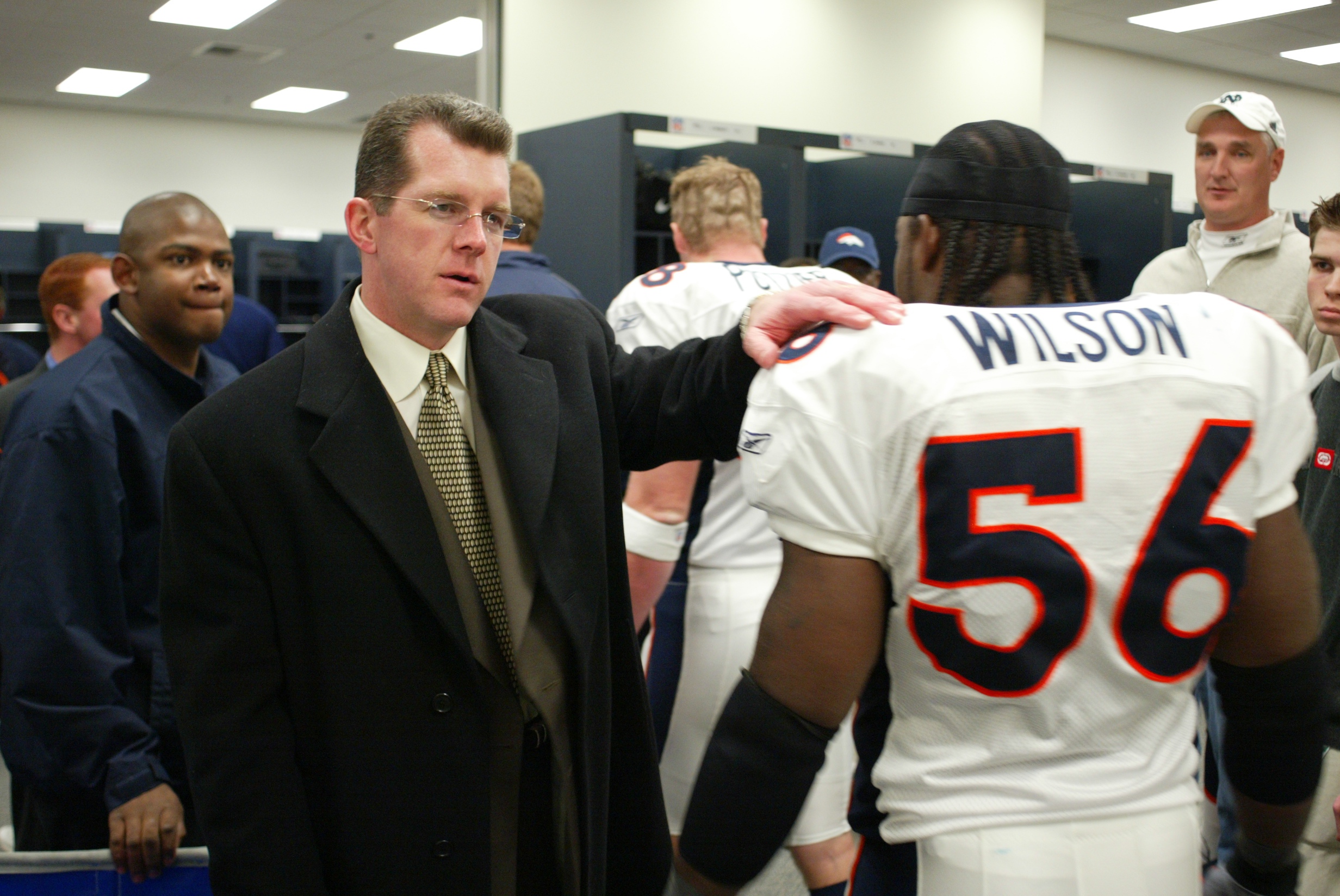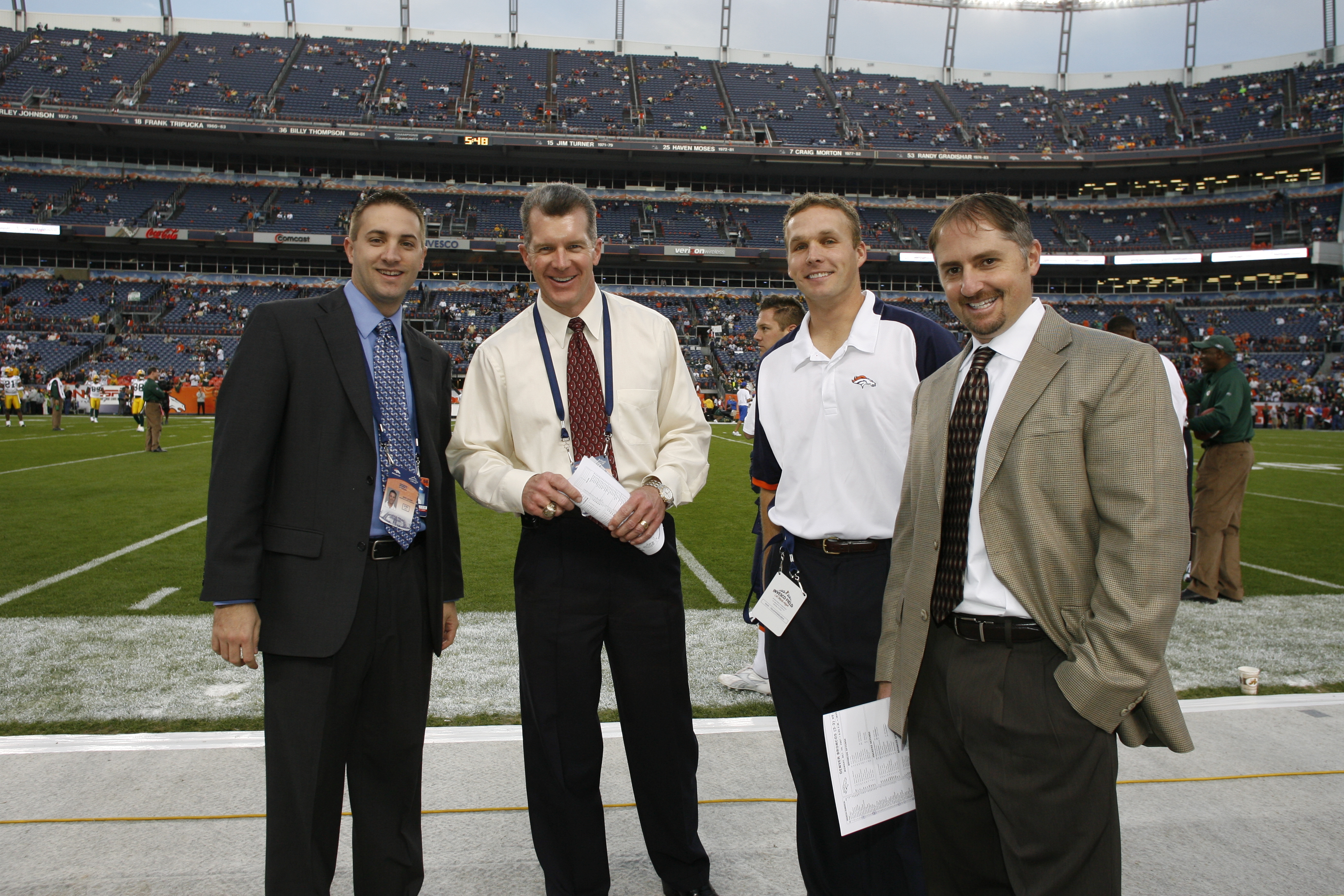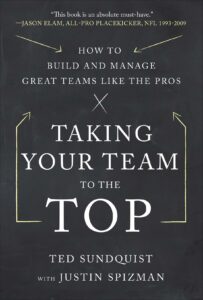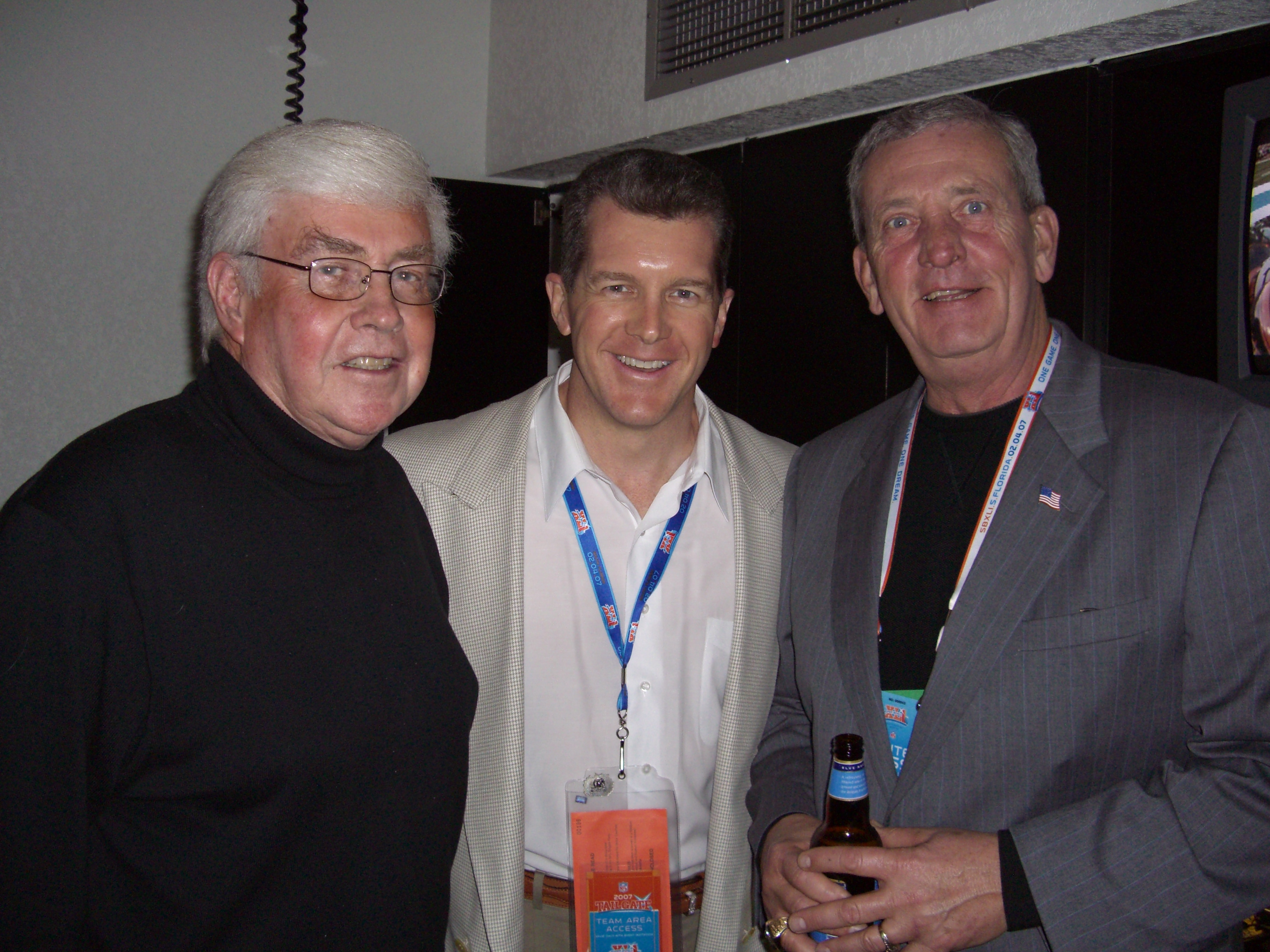How to Take Your Team to the Top
As a leader, how do you spot talent?
How do you take talented individuals and turn them into a winning team?
How do you create a winning culture?
Is it possible to use adversity to your advantage?
What team is the greatest of all time?
I asked Ted Sundquist all of these questions and more.
Ted Sundquist played fullback at the U.S. Air Force Academy, winning the 1982 Hall of Fame Bowl and the 1983 Independence Bowl. He later served as a flight commander in Germany before returning to the Academy and coaching. In 1993, the Denver Broncos hired Ted as a talent scout. Ted was named General Manager of the Broncos in 2002. Today, Ted is an analyst for the NFL network, a radio personality, a commentator and a blogger. This year, he added author to that list with the publication of Taking Your Team to the Top.
Identifying Talent
Ted, you’re known for grabbing talent others passed over. How were you able to see potential where others saw problems?
I think first and foremost you have to identify the talent pool that you’re dealing with. Understand where the best and the brightest come from that can contribute to your industry. In professional football, that’s dealing with the entering college football player pool, as well as players already in the NFL, and those available on the street (free agents).
Then you have to have a VERY good understanding of what traits are necessary in these individuals in order to execute the plans & procedures required to pursue your mission. One size doesn’t fit all when it comes to football, and I’m sure that’s the case in other arenas as well. We had prioritized our requirements prior to searching for those individuals to fill our positions of need.
You must be as detailed with the back end of your prospect list as you are with the top candidates. Look for those individuals that fulfill your priorities in the Critical Factors, those traits which run “vertical” through the organization and are analogous for every person on the team, regardless of position. Know which factors are most important and which you can “live with.” Then have a thorough breakdown of the Position Specifics, those skills necessary to fulfill a specific task required of the candidate.
Ensure that the positions are evaluated from various angles within the organization and not from a single viewpoint. This eliminates personal bias and provides for a crosscheck of opinions. Mistakes made on the front end of the selection process are difficult to correct once the player is on your team.

If you take the time to do your homework, finding the pool of talent, identifying what’s most important to your team to accomplish the mission (Critical Factors [vertical traits] & Position Specifics [horizontal traits]), and then implementing an evaluation system from multiple angles & crosschecks . . . your chances of making mistakes are minimized and you’re more apt to find the best and the brightest talent to execute your plans towards goal achievement.
Creating A Team Mission Statement
You define a team as “two or more people combining their innate skills, abilities, and strengths to accomplish a goal or mission that would be unachievable by an individual.” The goal may be obvious in football, but it isn’t always as obvious in business, government or non-profits. How do you create alignment and common purpose?
It’s imperative to have a well thought out mission statement. Many organizations operate with the assumption that their efforts are intuitively understood by all the team members, when very often they’re not. When confusion exists, answers will be made up by individuals or factions within the team to fill the void. This can create internal competition and/or dissension within the team.
When team leadership is clear about the purpose of the joined efforts of all its team members, and when every team member understands his or her own role in achieving the stated goals, then efficiency of effort is more likely to take place.
When team members lose focus of their own purpose in the stated mission, they begin to shift their energies toward the efforts (or non-efforts) of other team members. This creates an imbalance within the team and can bring ALL operations to a halt.

I like to use the acronym F.U.D.E.S. to make my point:
FOCUS – All efforts and operations should focus directly on mission accomplishment. Team members should always ask themselves, “Will this HELP the team achieve its stated GOAL?”
UNITY – All efforts should help unify the shared work of the team and promote synergy amongst individuals and groups within the team.
DIRECTION – All efforts should be clearly defined, with detailed plans and procedures to ensure at a minimum the accomplishment of the required task. Teams that provide concise direction also allow for flexibility within their operations that account for the dynamics of individual circumstances and situations facing team members.
EXCELLENCE – All efforts will be set against a standard of excellence that cannot be diverted from. “Good is not good enough.” Continuing evaluation and review of performance will help lead team members’ efforts towards excellence in all of their efforts.
SUCCESS – Understanding that when there is a common focus towards mission accomplishment, unified efforts in achieving mission accomplishment, clear and concise direction provided to all team members in their particular responsibilities towards mission accomplishment, and excellence in the production of those responsibilities, then “success” is inevitable.
It All Starts With Morals
What may be surprising to many is where you say it all starts, the fundamentals of teamwork and success. You say it all starts with morals. Elaborate on that for us.
I think this goes back to the basic understanding of why a TEAM has been brought together in the first place and being able to look in the mirror and see how the combined efforts of many reflect upon the original thought process towards an overall MISSION.
By seeking out and selecting those talented individuals with the CRITICAL FACTORS that you want to run throughout your organization, you’re more apt to put together teams that understand the F.U.D.E.S. process.
 By morals I’m speaking of honor, integrity, work ethic, humility, compassion, patience, etc. Any and all traits directly reflective of the founders of the TEAM and the MISSION they set forth. They can also emanate from the current leadership as well. They (the moral/critical factors) won’t necessarily be the same across any industry and will more than likely be unique to each group or team.
By morals I’m speaking of honor, integrity, work ethic, humility, compassion, patience, etc. Any and all traits directly reflective of the founders of the TEAM and the MISSION they set forth. They can also emanate from the current leadership as well. They (the moral/critical factors) won’t necessarily be the same across any industry and will more than likely be unique to each group or team.
But what I see are successful organizations that are grounded in their principles regarding “how” they go about their business. Those successful teams/organizations are predominantly steadfast in their “make up” and “moral compass.” They don’t let outside pressures or dynamics change who they are and what they believe in, but they are willing to show flexibility and change in order to maintain F.U.D.E.S.
Creating A Winning Culture
Throughout your book, you talk about the importance of a winning culture. Here are three quotes I noted:
- “Good teams incorporate teamwork into their culture, creating the building blocks for success.”
- “The culture should reflect the mission.”
- “A positive culture for an employee is like a nutrient rich soil for a vegetable – it promotes development and progression.”
How do you create a winning culture? How do you sustain that winning culture?
Creating a “winning culture” is difficult, balancing accomplishment of the overall mission and simultaneously cultivating the individuals tasked with the responsibility of doing just that. It seems almost ludicrous to bring together all the necessary resources of time, money, personnel, effort, and equipment and then not achieve a stated goal. So for many leaders the emphasis is solely placed upon MISSION accomplishment, at all costs!
Other teams get caught up in the maintenance and details of the above mentioned resources and never bring them together in order to accomplish the stated MISSION. They become mired in a myriad of subterranean problems that don’t provide focus, promote unity, give direction, or demand excellence.
Winning cultures emerge from understanding that a team’s number one asset is its members. Great teams cultivate and develop those assets to their fullest. They challenge their members in a constructive manner and provide the necessary resources (in all forms) for them to accomplish their responsibilities. They provide conduits of communication, give timely feedback on ongoing operations, and are available for questions and concerns. Winning cultures thrive on the growth and advancement of their own. They look to promote from within and encourage upward career movement, even if it’s outside of the team.
Sustaining a winning culture requires flexibility, while adhering to the original principles that helped mold the MISSION statement of the organization. It goes back to selecting the right people and indoctrinating them into the way the team goes about doing its business: day to day, week to week, month to month, milestone to milestone.
Where I’ve seen winning cultures quickly fall apart is when outside personnel are brought in that don’t understand or agree with the morals and principles the team was built upon. If unchecked, these individuals can destroy years of work in a very short period. The analogy of a “cancer” to the team is probably the most descriptive.

The Greatest Team Ever
I was very curious to read your opinion of the greatest team ever. Who would Ted Sundquist credit as the greatest team? You didn’t choose the 1985 Chicago Bears or the 1990’s Bulls, or even the Patriots in the twenty first century. You picked a team from Apollo 11. Tell me why that’s the best team ever.
President John F. Kennedy’s challenge to send a man to the moon and return him safely home by the end of the decade (‘60’s) was meant to mobilize an entire nation behind the pursuit of a common goal. This would require literally building this “team” from the ground up, developing new technologies, testing unfounded theories, training personnel in areas never before “operationalized,” overcoming immense adversity, dealing with outside distractions, and facing a self-imposed time limit.
Kennedy would never live to see this goal accomplished and yet the country carried on towards his vision. The Apollo 11 mission was the culmination of a number of benchmark steps towards achieving this goal as a nation. When you think of the thousands of people involved and the immense financial commitment, the various disciplines that had to be integrated, the focus maintained in the wake of tragedy (Apollo 1), the level of technology in comparison to today, not to mention the fact that it was something never before attempted under what truly could be deemed life and death circumstances – it was a historic TEAM accomplishment.
The United States sent men to the moon and returned them safely to earth – 44 years ago!
One of your management philosophies is “less is more.” That’s when “you don’t necessarily tell people how to do things as much as you tell them what needs to be done.” That only seems possible when you’ve followed your formula of finding the right talent, then placing them in the right positions. Why is this philosophy so important to success?
I think asking people to do things out of the realm of their training or capabilities is a disservice to both the individual and the team. Most goals or missions are initially set with a passion for their accomplishment. You have to find team members who can share in that passion and who understand their roles (however big or small), in attaining success.
People with a shared passion and the proper training will FIND ways to ensure that all efforts will be exhausted in order to get the job done. Given the flexibility to adjust and divert resources of time, money, manpower, and any other necessities, they’ll put together the proper combinations (under the given circumstances) to ensure the success the TEAM is seeking.
Without the motivation and understanding of what needs to or must get done, teams wallow in the conditions of their current situation, not knowing or caring to take the necessary steps to continue forward, and not having an investment in the final outcome. This is a recipe for failure.
Dealing With Adversity
Every good team has to deal with adversity. You talk about planning for it, training for it, dealing with it, and even benefiting from it. The formulas you provide seem straightforward, but not many have seen your level of success. How do you teach up-and-coming leaders to deal with adversity and benefit from it?
In Taking Your Team To The Top I stress the importance of “analyze, adjust, and eliminate.” We’ve all heard the adage, “The best laid plans of mice and men,” and though every possible situation can’t be planned for, you can certainly attack adversity in midstream by following the above axiom.
Stay true to your standardized procedures that ensure communication up and down the chain. Move forward with the necessary revisions as quickly as possible. It’s important to show strength and confidence in your leadership. Eliminate the issues that may be causing your team problems. Otherwise some members will work to find their own solutions that may be counterproductive to the entire team’s goals.
I talk about the strength that teams gain from being “Forged under fire.” Great teams learn from their mistakes and quickly shore up their weaknesses.
“Recognize, review, revise, and refocus.” One of the biggest mistakes young leaders make is not acknowledging that they have problems in the first place and don’t necessarily have all the answers. Open-mindedness is crucial to recognizing adverse stress on your team. The best teams I’ve worked with have built-in review processes that identify areas of weakness and the possible reasons that caused the team to falter.
Accepting these identifiable points of concern will then allow for the necessary revisions in plans, training, procedures, or personnel to remedy the problem. Quickly communicate these corrections to the team and refocus their efforts on the goal or mission. Dwelling too long on failure will tug at other areas of the equation to eventual success, unity, direction, and excellence.
Even the greatest of teams will fail, but sustained determination in identifying the problems and making the necessary corrections in mid-stride will help overcome the inevitable setbacks along the way.
Recognizing A Winning Team
Your entire career has been based on teamwork. You’ve scouted great individuals and created winning teams. How do you recognize a winning team? Would the characteristics be the same in the boardroom as they would be on the football field?
The most recognizable factor in winning teams is “communication.” That may seem rather simplistic, but think about some of your own team efforts that have failed, and I’ll wager they circle back to some sort of communication failure.
Whether it’s ensuring everyone understands their role and how they fit into the bigger picture of the mission statement, or it’s someone who feels less than appreciated for their own perceived efforts in accomplishing a goal. Perhaps it’s the lack of understanding in what is required of an individual in a specific task or what standards of production are expected with the final outcome. Great teams are able to communicate both verbally and through non-verbal cues. They have almost a sixth sense of what is necessary before even taking the next step. As cliché as it sounds, they’re all on “the same page” when it comes to operational efforts.
At the risk of redundancy, F.U.D.E.S. Winning teams filter everything they do through this equation, and if their efforts don’t maintain focus, create unity, provide direction, and demand excellence, they find an alternative operational method of executing their plan. Seriously, stick with it and success is inevitable.
The reason I wrote Taking Your Team to the Top in the manner in which I did was because I truly believe these same principles that create great teams on the playing field will also cultivate winners in corporate boardrooms, academic classrooms, as well as local, state, and national “town halls.”
A head coach is always focused on the next win. As a general manager, I would imagine you are thinking about longer-term success. That tension between the near-term and the long-term is a constant struggle for many great organizations. How did you deal with it?
There is definitely a “push pull” dynamic between the short-term interests of WIN NOW and the long-term health of any team or organization. The responsibilities of the head coach and those of the general manager will at times collide within those two opposing viewpoints.
Inherently I see the angle of a head coach wanting to WIN in the short-term, at the expense of long-term stability, as self-centered. To jeopardize resources at all costs for the final outcome of a given game or season is more focused on self-preservation in the face of judgment, criticism, or blame than what’s best for the overall interests of the team.
However if front office leadership (general manager) does a poor job of communicating the objective of the bigger picture, building sustainable success over multiple seasons, and then doesn’t adhere to his or her own long-term plan but rather shifts blame to coaching, that’s just as narcissistic.
Success can be its own worst enemy, and those that strive to gain a greater title or recognition as a result of the combined efforts of many will usually end up being the “identifiable weakness.” Leaders who lose their focus and whose actions promote disunity will ultimately destroy the SUCCESS equation, whether short or long-term.
Leading a team in any capacity is not a right but rather a privilege.
Taking Your Team to the Top

